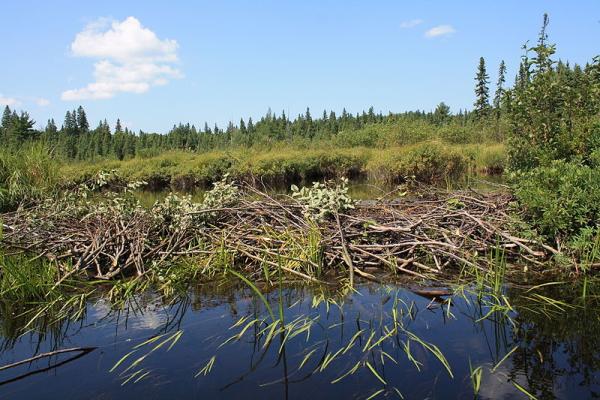
Even in the Colonial era, European settlers impacted the hydrology of rivers in what is now the northeast region of the United States. Trapping of beavers reduced their population and led to the collapse of many of the dams they built. A CCNY-led team has devised a methodology for recreating the hydrology of this region between 1600 and 1800. (Wikipedia photo by Franklin Vera Pacheco used under Creative Common Attribution Share-Alike license.)
Work Demonstrates Benefits of Scholarly Ties Between the Humanities and the Sciences
Hydrologists may have a new way to study historical water conditions. By synthesizing present-day data with historical records they may be able to recreate broad hydrologic trends on a regional basis for periods from which scant data is available.
Lack of reliable historical data can impede hydrologists’ understanding of the current state of waterways and their ability to make predictions about the future. That was the case for the rivers of the northeastern United States between 1600 and 1800, a period that runs from just before the first European settlers arrived to the onset of the Industrial Age.
“The historic perspective is important because humans have developed a particular approach to water that may not be sustainable,” says Dr. Charles Vörösmarty, presidential professor of civil engineering in The Grove School of Engineering at The City College of New York. “(People) often impact a system and then spend lots of money to fix it. By studying how systems evolved, we may be able to look at success stories of the past and avoid problems emerging today and in other parts of the world.”
Professor Vörösmarty was principal investigator for the study, which was produced by an interdisciplinary team of researchers from 15 institutions. It was one of just two funded under the National Science Foundation’s Continental Hydrological Processes Program, and is a major component of a multi century-scale study of waterways in an area stretching from Maine to Chesapeake Bay.
“The reconstruction makes it possible to discern broad hydrologic trends,” said Christopher L. Pastore, a University of New Hampshire historian and corresponding author for the report, which was published this month in “Environmental Science & Technology.” “We're laying the groundwork for understanding the big picture: how Americans interacted with and changed their water resources over the broad sweep of time.”
Graduate students attending a summer institute at Massachusetts Institute of Technology developed the conceptual model and recommendations. They identified four principal drivers of hydrological change: water engineering, land-cover change, climate change and human decision-making. The latter was overarching because it affects the other three. The model identified a baseline environment for the year 1600 and then worked forward.
Europeans’ impact on the waterways was felt soon after they arrived, Professor Vörösmarty noted. For example, demand for beaver pelts reduced their population, and the dams the beavers had built collapsed because they were no longer being maintained. The signature of these changes was mapped on a regional scale and found to be substantial.
To develop their methodological model, the team first projected known data sets into a geographic information system and conducted simulations using hydrological models that were calibrated to modern data sets. Further corroboration was achieved, for example, by using British census records and local histories.
From these, they could estimate deforestation patterns and local hydrology change. Where possible, they scaled up these hydrological “snapshots” to make assertions across a larger area.
To apply the model, the team divided the region into three historically consistent sub-regions – New England, the mid-Atlantic colonies and the Chesapeake Bay area – and studied the effects of physical variables such as soil and climate and sociopolitical factors.
These human factors had significant impact on hydrological development. While the close-knit, religious communities of New England concentrated on fur trading and timber extraction, Chesapeake region saw widespread tree clearance and tobacco planting.
In addition to showing how the results of studies based on contemporary data sets can be corroborated with the accounts of environmental historians to reconstruct colonial-era hydrology, the work “underscores the importance of forging scholarly ties between the sciences and humanities.”
“This opens the disciplines to new ways of thinking,” Professor Vörösmarty said. “Geoscientists may be keyed into numerical data, use of maps and other quantitative data while historians take narratives and look at other information to construct a picture.
“We can assemble a picture that starts with information sets and they can corroborate what the data show. The historical scholarship community can take their studies to the next level by adapting quantitative information so the specifics they find through documenting local-scale histories can be reconfigured into broader generalizations.”
MEDIA CONTACT
Ellis Simon
p: 212.650.6460
e:
esimon@ccny.cuny.edu